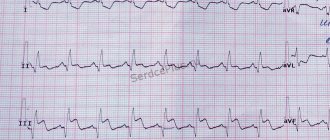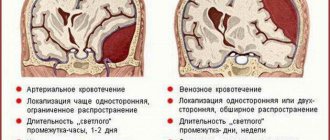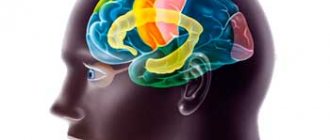Paranoia is a mental disorder that causes an individual to experience unreasonable fear. Such diseases cannot be fully classified as pathologies; paranoia has the ability to manifest itself as a symptom of some pathology and is a small part of a disease, for example, schizophrenia. And if paranoia is the only symptom, then it is inherent in a completely healthy, so-called paranoid individual with radical fear. The individual will worry and constantly assume the worst, worry and will not lag behind the others. In the social environment of almost everyone there is such a person. Such people are more prone to developing obsessions due to their innate paranoia, through the prism of which they view their surroundings.
Etiological factors
The reasons why paranoia manifests itself in people have not yet been reliably established. But in the course of various studies, it was found that most often the causes of this pathology are degenerative processes. In most clinical situations, paranoia is diagnosed in the elderly, but its manifestation cannot be excluded in people from the middle age group.
Reasons for the progression of paranoia:
- advanced age;
- Parkinson's disease;
- Huntington's disease;
- atherosclerosis of cerebral vessels.
The cause of the incoming form of paranoia may be the use of psychodysleptics. These include:
- narcotic drugs;
- some groups of synthetic pharmaceuticals;
- amphetamines;
- large doses of alcoholic drinks.
Causes of paranoid state
A paranoid state arises and develops as a result of brain damage, as well as certain mental illnesses.
The main causes of paranoia include:
- brain and skull injuries;
- brain damage of any origin;
- drug and alcohol addiction;
- constant stressful situations, depression;
- psychological trauma formed in childhood;
- metabolic pathologies that disrupt protein synthesis;
- age-related degenerative changes in the brain;
- Alzheimer's and Parkinson's diseases, atherosclerosis;
- genetic predisposition to mental illness.
One of the most common causes of paranoia is brain injury.
The risk group includes older people, individuals with a hereditary tendency to mental illness, drug addicts and alcoholics. In addition, men are more susceptible to paranoia than women.
Varieties
Psychiatrists distinguish the following types of paranoia:
- alcoholic. This type of pathology progresses in people suffering from alcoholism. Psychosis is chronic. Its main manifestations are a feeling of persecution and intense jealousy;
- struggle. The main manifestation of pathology is that a sick person constantly fights for his rights, which, in his opinion, are significantly infringed;
- lust. Manifests itself as delirium of an erotic or love nature;
- involutional. This type of pathology manifests itself in the fair sex immediately before menopause;
- hypochondriacal. The patient is sure that he is sick with various somatic pathologies;
- spicy. Characteristic symptoms of this form are delusions, hallucinations and stupor;
- persecutory. A sick person has the feeling that someone is constantly pursuing him. The appearance of delirium is also not an exception;
- acute expansive. A person exhibits delusions of talent, greatness, and power;
- sensitive – increased tendency to create conflict situations, the patient becomes more vulnerable and sensitive;
- conscience. The tendency to self-flagellation and self-criticism increases.
Paranoia and anhedonia
Anhedonia is a pathological condition in which a person experiences a loss of the ability to enjoy life.
There are often cases when this pathology accompanies paranoia, which causes the patient’s condition to become even more severe. This problem must be resolved with a specialist.
Today, if the disease is treated in a timely manner, it can be successfully corrected, which allows a person suffering from paranoia to live quite fully.
Signs of illness
It is not difficult to notice the signs of paranoia, as they usually appear quite clearly. A sick person develops overly valuable ideas (for him), which gradually develop into delusions of grandeur.
and become the reason that in all situations a person is able to see the machinations of his enemies. He is completely sure that a conspiracy is being woven around him, directed directly against him. Moreover, he explains this to others quite logically. In some cases, it is precisely this logic that becomes the reason that the patient’s relatives believe him and thereby postpone the visit to the psychiatrist. But under no circumstances should this be done. As soon as signs of paranoia appear, it is important to transport the patient to a medical facility as soon as possible to undergo a full diagnosis and prescribe the correct treatment plan.
In most cases, relatives do not believe a patient with paranoia. And it is their lack of faith in the patient’s delusional ideas that becomes the reason for the development of various conflicts, including domestic ones. The patient himself is very distrustful of the people around him. He also becomes touchy and even aggressive.
Diagnosis and treatment
The main condition for proper treatment of paranoia is taking medications.
In medicine, paranoia is not classified as psychosis, but a patient with paranoia has certain difficulties interacting with other people, which can cause a lot of inconvenience to both those around him and the patient himself. If a patient is diagnosed with paranoia, doctors prescribe him treatment, which consists of undergoing a course of psychological correction.
A complicating factor in the treatment of paranoia is that the patient may experience distrust of everyone around him, including doctors. Or, due to criticality towards the entire world around him, the patient may refuse to admit the fact that he has a disease such as paranoia.
Therefore, the main task for a doctor is to establish good and trusting contact with the patient. As a rule, this is difficult to do, and it may take a lot of time for the doctor to win over the patient and begin to effectively fight the disease.
Thanks to psychotherapy, the patient begins to control the symptoms of the disease, feels the approach of an exacerbation and takes certain actions to alleviate or prevent it. There are several types of therapy that can help cope with paranoia. For example, thanks to cognitive behavioral therapy, the patient will be able to change his behavior pattern at the right time in order to prevent relapse.
As for the question - “how is paranoia treated?”, then everything is quite twofold - some patients who have just begun to show some symptoms of paranoia cope with this problem forever. But there are also a large number of patients in whom attacks of paranoia alternate with a certain remission.
As already mentioned, a lot depends on at what stage of development of paranoia this disease was discovered. Due to an overly critical perception of the surrounding world, the patient himself may not notice the manifestations of paranoia, even with its strong development. For this reason, many patients end up seeing a doctor at a time when the disease has already reached a strong stage of development, and in this case it will be much more difficult to help the patient.
- Taking neuroleptics, antipsychotropic drugs;
- Taking sedatives;
- Family psychotherapy;
- Tranquilizers;
- Individual psychotherapy;
- Antidepressants;
- Psychotherapy, which includes the use of cognitive behavioral methods.
In case of psychological trauma, the psychotherapist tries, together with the client, to find the situation that negatively affected the person’s calm. The specialist explains that people around do not wish harm.
The psychologist is trying to show with facts that there is no “universal conspiracy.” She also uses various techniques to increase the client’s self-confidence and self-esteem in particular.
Symptoms
Symptoms of paranoia in women and men are as follows:
- increased mental activity. The patient evaluates the situation from different points of view. Even in ordinary things he sees a conspiracy, a threat to himself, etc.;
- increased physical activity;
- lack of desire to make contact with other people;
- aggression;
- negative attitude towards close relatives and friends;
- auditory hallucinations. A person with paranoia tends to hear sounds that do not actually exist;
- tactile and visual hallucinations;
- disorders of the musculoskeletal system. A patient with paranoia often changes his gait, facial expressions and gestures.
International Classification of Diseases[ | ]
ICD-9[ | ]
In the International Classification of Diseases, Injuries and Causes of Death, 9th revision (ICD-9), paranoia was a separate category and was described as a rare chronic psychosis, characterized by the gradual development of logically constructed, systematized delusions (delusions of grandeur (paranoid prophet or inventor), delusions of persecution or hypochondria), without the accompanying disorganization of thinking of the schizophrenic type and hallucinations[4]. in classification: 297.1297.1.
Excluded: paranoid personality change (301.0301.0).
ICD-10[ | ]
In the version of ICD-10 adapted for use in the Russian Federation, there is a subcategory of delusional disorder F22.01xx - paranoia (it also includes “paranoid personality development”). The categories F22.8 and F22.88 “other chronic delusional disorders” include a querulant form of paranoia[9]. In the official ICD-10, issued by the World Health Organization, paranoia is not classified as a separate category; it corresponds to delusional disorder (22.022.0).
In mild cases, similarities to paranoia speak of paranoid personality disorder (60.060.0)[10]. The term “paranoid” means “paranoia-like” (from paranoia + -oid - Ancient Greek εἶδος - “similarity”). Thus, the meaning is that it is a “paranoia-like personality disorder.” There is also a form of schizophrenia similar to paranoia - paranoid schizophrenia. In schizophrenia, the paranoid (transient) stage of delusion may precede the paranoid stage. Also in the ICD-10 adapted for Russia there are headings F22.03 - paranoid schizophrenia with sensitive delusions of relationships and F22.82 - paranoid schizophrenia [9].
Causes of paranoia
The cause of the development of paranoia is certain metabolic disorders in the brain in combination with initial personality characteristics, stereotypes of interpreting certain situations developed from childhood, habitual ways of responding to stress and unfavorable life circumstances. Patients suffering from paranoia have a hard time dealing with failure from an early age. They are prone to inflated self-esteem, often show dissatisfaction, do not know how to forgive, react too belligerently to any issues related or supposedly related to individual rights, distort facts, interpreting neutral and friendly actions of others as hostile.
With paranoia, a complex transformation of one’s own aggressive impulses and the attribution of these impulses to others occurs, only in a different form, changed beyond recognition. The process involves defense mechanisms such as projection, reaction formation and denial. For example, a patient with paranoia feels love for another person, but feels the need to deny it. “I love him” turns into a reactive formation of “I hate him” and, due to projection, enters consciousness in the form of “he hates me.”
All of the above causes constant conflicts with other people.
A kind of vicious circle arises - a patient suffering from paranoia provokes others to aggressive actions with his behavior, and subsequently considers this aggression as a fact confirming his picture of the world. A patient with paranoia develops a stable system of ideas: “people are really hostile, you need to be constantly on guard, you need to protect yourself, including revealing their “dark plans” before they have time to translate their plans into reality.”
The more hatred, contempt and other similar feelings a patient with paranoia “sees” in the world around him, the more he “protects himself from enemies” and the more unfavorable the atmosphere in which he exists becomes. With age, paranoia worsens, the patient becomes vindictive, jealous and suspicious. With paranoid personality disorder, stabilization often occurs at this stage.
With mental disorders, chronic intoxication and degenerative diseases of the brain, the picture of the development of paranoia changes. In youth and middle age, paranoid personality traits may not be expressed or weakly expressed. As the underlying disease progresses, the patient's character gradually deteriorates. Typically, paranoia caused by other diseases and pathological conditions develops in the second half of life. Its cause may be Alzheimer's disease, Huntington's disease, Parkinson's disease, cerebral atherosclerosis, drug addiction, chronic alcoholism, or taking certain medications.
Paranoia can be aggravated under the influence of any unfavorable life circumstances: deterioration of relations with a spouse, divorce, death of a loved one, problems at work, financial difficulties, unfavorable outcome of a lawsuit, etc. Based on a traumatic situation, a patient with paranoia forms an overvalued idea or delusional system. At the same time, paranoid ideas often affect only one part of life; in other matters, the patient maintains adequacy of behavior and logical judgments. This, as well as the ability to plausibly integrate real circumstances into one’s system of paranoid beliefs, inspires the trust of others, and a patient with paranoia (usually with relatively favorable forms of the disorder) tries for a long time to implement his system without attracting the attention of specialists.
Causes
It can develop due to a defect in protein metabolism, which affects the coordinated functioning of neurons. Actually, various disorders in the nervous system can also affect the psyche.
Older people may develop diseases such as Alzheimer's and Parkinson's. With them, memory (what is it?), attention, thinking, and emotional background suffer. Changes occur in the personality itself: people become angry and suspicious.
If one of your relatives had similar symptoms, they could be passed on through heredity.
Education is also a common cause of the disease. For example, a child was scared that there were evil people around who could cause harm. They should not be trusted, and it is better to avoid them. Or the child heard from mom and dad that their neighbors and friends were jealous of their family.
Perhaps, already in adulthood, the person suffered serious psychological trauma. People close to you deceived you, set you up, or you just got caught by an unfriendly group. After which the traumatized person begins to approach everything with fear.
When for some reason you had to be in long-term isolation from society (for example, a serious illness), then after entering society there may not be a quick adaptation. Therefore, a person may be afraid and wary of others.
The causes of paranoia, and many other mental disorders, have not been thoroughly studied, and therefore it is not always possible to say exactly what exactly led to the emergence of paranoia in a particular case. We can only list the reasons that can contribute to the appearance and development of this disease:
- Head injuries;
- Hereditary tendency;
- Pathological conditions in the brain;
- Drug or alcohol addiction;
- Frequent stressful situations;
- Social isolation;
- Disruption of metabolic processes associated with the process of protein synthesis;
- Age-related changes in the brain;
- Psychological trauma received in childhood;
- Long-term use of medications;
- Some chronic diseases;
- Previous brain diseases;
- Dissatisfaction with life.
Speaking about the causes of paranoia, it makes sense to identify groups of people who are more prone to developing this disease:
- Genetically predisposed people;
- People with drug or alcohol addiction;
- Elderly people;
- Men over twenty years old;
- People who are initially prone to depression or other mental disorders.
The exact causes of the disease are still unknown, but there are still some assumptions. This is about:
- Defects of protein metabolism in the brain.
- Neurological disorders.
- Psychological trauma received in childhood.
- Hereditary predisposition.
- Long-term depression, psychosis, emotional overload and low self-esteem.
- Isolation from society.
- Chronic lesions such as Parkinson's or Alzheimer's disease.
- Difficult circumstances in life.
Paranoia is often provoked by taking certain medications, drugs, drugs and alcohol. Another risk factor is advanced age, accompanied by age-related changes in the brain.
It is worth knowing the rather controversial opinion about the onset of the disease due to the consumption of strong coffee, which stimulates insomnia and psychosis, causing paranoia if unfavorable factors are present.
Symptoms of paranoia
First, highly valuable ideas are formed related to certain circumstances of the patient’s life. A patient with paranoia may be excessively jealous, believe that colleagues are in cahoots and are deliberately preventing him from advancing in his career, that his boss is planning to destroy his professional reputation, or that he is deliberately not recognizing his outstanding achievements. Paranoia often provokes conflicts with neighbors, public utilities and representatives of official structures.
A patient suffering from paranoia may suspect neighbors that they are planning to drive him out of the apartment and are deliberately carrying out various sabotage activities. Intolerance, scrupulousness and belligerence inadequate to the circumstances in matters of individual rights sometimes become the cause of litigation, during which the patient with paranoia files complaints to various authorities, initiates endless trials and challenges court decisions.
Patients with paranoia sense the slightest insincerity and easily recognize attempts to hide something. Since people are rarely completely frank, and patients interpret any lack of frankness in light of their paranoid system, they very quickly accumulate a huge amount of “compromising evidence” on others. As the disorder progresses, the patient with paranoia begins to endlessly “fight” with the authorities, try to expose the unfaithful husband or wife, etc.
Along with the formation of highly valuable ideas, other changes in character and behavior are observed. Patients suffering from paranoia appear cold and aloof. There is a noticeable low ability to empathize, a lack of empathy (except for topics of special interest). People with paranoia find it difficult to work in a team; they constantly defend their independence and reject authority. At the same time, they perfectly see social and personal connections in the group and consider these connections in the context of their highly valuable ideas.
Overvalued ideas progress and transform into persecutory delusions or delusions of grandeur. Delusions of grandeur are characterized by the idea of one's power, genius, and unusual power. With paranoia, such delirium is often manifested by conviction in one’s exceptional abilities (professional, inventive, creative). At the same time, the patient with paranoia is convinced of the conspiracy of those around him, who in every possible way prevent the disclosure of these abilities (they deliberately do not publish his works, do not recognize his inventions, etc.).
The content of persecutory delusions is damage, harm or suffering allegedly caused to the patient by other people. A patient with paranoia believes that he is constantly being closely watched for some specific, clearly malicious purposes. Moreover, unlike patients with delusions of grandeur, patients with persecutory delusions are very reluctant to share their suspicions with other people. The delusional system can be completely hidden from others or known only to the closest people (spouse or child). Close relationships distort perception, the relatives of a patient with paranoia “plunge” together with him into his delusional system, and they develop induced delusions.
In severe cases, paranoia pushes patients to change their lifestyle and entails a decrease in social status. Patients may skip work or quit their jobs to track down their spouses, may spend all their time going through the authorities, and all their money on paying lawyers. Under favorable living conditions, the symptoms of paranoia become less pronounced. In unfavorable circumstances, a state of compensation is difficult to achieve even with the constant support of a psychotherapist or psychiatrist, since patients with paranoia are extremely suspicious of people (including doctors) and have difficulty changing their views and beliefs.
Diagnostics
To determine what is the cause of the patient’s paranoid behavior, a psychiatrist carries out the following diagnostic measures:
- Personal consultation with a specialist. The doctor talks with the patient, interviews him, and during the conversation determines whether the person suffers from mental disorders.
- Psychometric methods. They include filling out questionnaires and tests that identify symptoms of a paranoid state. Depending on the specific study, responses may be entered by both the patient and his or her physician.
- Laboratory tests, including blood tests: general, hormonal.
- Instrumental diagnostics using special devices. This group includes CT and MRI of the brain, electroencephalogram, angiogram.
To diagnose paranoia, the doctor must determine that the patient has paranoid ideas that do not go away within a month, and exclude the possibility of other disorders.
What is paranoia?
Paranoia has different interpretations, but they all come from Greek, according to one of them paranoia is translated as thinking, in another “para” means around, and “noos” means thoughts or mind and therefore it literally comes out as thinking. On the one hand, a more common definition of paranoia is a mental disorder that goes along with or is suspiciousness itself, a tendency to identify evil intent in everything. This is what we mean when we talk about a paranoid individual. This does not imply a mental illness as such, just a personality trait. Such individuals are suspicious, suspect everyone of every little thing, and they simply do not have accidents.
But in fact, paranoia has another distinct meaning, which was once taken into account in psychiatry. This pathology was first identified by the famous psychiatrist Kalbaum, who observed many such cases in elderly individuals. This discovery took place in the 19th century, but this diagnosis is not made now.
he called delusion and all delusional disorders paranoia, he outlined their danger to the environment and the negative impact of the presence of such on the patient himself. Later, Kraepelin studied paranoia and indicated that only a small percentage of such symptoms contained paranoia itself. Back in ICD 9, this pathology was a separate rare type of psychosis. Now ICD 10 has an extensive database that allows one to reliably make a diagnosis based on syndromic and nosological principles. And yet it is worth noting that paranoia is unlikely to disappear from the general vocabulary due to the originality of the expression, which allows us to emphasize the personality of the individual.
Speaking about the epidemiology of the disease, it is important to note that paranoid disorder itself, as the second definition of delusional ideas, is observed in only 0.5% of patients, and the rate is decreasing. But at the same time, paranoid personality traits in a more common sense are inherent in a much larger number of individuals. Oddly enough, according to social research, men are more susceptible to this group of pathologies and this type of personal behavior. Paranoia in men, taking the entire population group, is about 13%, which exceeds the female contingent. Paranoia in women approximately occurs in about 6% of the population.
How to get rid of paranoia on your own?
It is not possible to get rid of the disease on your own, but curing the pre-paranoid state is quite possible. For this purpose, several methods of self-therapy have been developed that can reduce the load on the central nervous system.
The most effective ways are:
- Keeping a diary. This measure allows you to release depression and stress, as well as get rid of obsessive thoughts by visualizing them on paper. The diary will also help to identify moments that provoke a paranoid state and promptly prevent their occurrence.
- The assumption of the thought that the first perception may be erroneous. This allows you to somewhat reduce suspicion and anxiety.
- Accepting yourself as you are. You should not condemn yourself, much less punish yourself, since every action, even if it is not correct, also has a positive effect, since it brings experience.
- Switching from paranoid thoughts. Usually, in a state that has not yet turned into an illness, a person feels moments when he begins to “obsess over” something. For this reason, as soon as negative obsessive thoughts appear, you should urgently distract yourself from them with the help of music, a movie or sleep.
Also, if you suspect a pre-paranoid state, it is best to visit a doctor to prevent the disease.
Causes of paranoia
Paranoia is formed according to different principles and can be based on completely different diseases, which significantly affects both the symptoms and the safety of the individual. It develops due to neurotransmitter disorders, in particular dopamine disorders.
If this is paranoia as a type of personal behavior, then it is formed from childhood due to certain educational characteristics. Any individual develops a certain type of response to stressors, which is difficult to change. It is he who determines the type of reaction to everything new and incomprehensible that happens.
Life situations play a big role in the formation of paranoia; if an individual of the paranoid type has at least once asserted for himself that he is personally right in a situation where he is paranoid, then he will be even more convinced of the conspiracy around him and will interpret everything even more pathologically. Often, an individual transfers auto-aggression, that is, directed inward, onto others without noticing it due to internal defense mechanisms. These can be different defense mechanisms, for example, projection or denial; the individual himself does this unconsciously and suffers greatly from this. If a personality has developed into a paranoid type, then it is difficult to return and the condition worsens with age. Often a larger circle of individuals is included in this process. In general, such an individual is hostile to everyone.
Paranoia in children is usually a consequence of incorrect upbringing, leading to unnecessary fears that are harmful to the child.
Paranoia can be part of the structure of schizophrenia, which has slightly different aspects of manifestation, but is very dangerous for the person himself and for those around him. Paranoia is not a characteristic syndrome in all forms of schizophrenia; this syndrome is still most characteristic of the paranoid form of the same name.
Paranoia in women is often formed under the influence of the endocrine system, especially during menopause. This pathology is considered involutional paranoid.
Paranoia in men (and less often in women) is often triggered by alcohol intoxication. Less commonly, it can be drugs or any toxic substances. But with prolonged use of alcohol, alcoholic paranoid will undoubtedly form. Many diseases can produce symptoms similar to paranoia or paranoid characteristics, in particular these are senile dementia diseases if they are mixed with psychotic symptoms.
Paranoid can provoke Alzheimer's disease, Huntington's chorea. Parkinsonism and even vascular diseases can cause syndromic paranoia. Paranoia can be a hidden personality characteristic that manifests itself in moments of despair, the death of a loved one, divorce proceedings, or enormous stress. Paranoia can develop as a neurotic process even in healthy people during critical times, for example, during constant travel, in wartime, or during long train rides. Blind and deaf people can sometimes develop the feeling that everyone is discussing and slandering them. Also, paranoia can strike a “narrow-minded” individual living with a mentally ill person who already has paranoia, a type of induced delusion.
Treatment of paranoia
To treat paranoia, an integrated approach is important. Paranoia in men with alcohol complications is relieved by withdrawal from the state of dependence, only then the disease slowly goes away. Paranoia in menopausal women requires some hormonal adjustments and, in some cases, daytime antipsychotics, like Eglonil. Paranoia in children is deactivated with the help of a gentle normal daily routine, proper activities with the child, the work of a psychologist and art therapy, and in no case should you frighten the child.
In severe cases, if paranoia is of a clear psychotic nature, that is, it lies in the structure of schizophrenia or delusional disorder, it must be treated accordingly. Antipsychotics with a sedative effect when excited are used: Aminazine, Tizercin, Truxal, which has an anxiolytic effect. Since delusional ideas are a productive syndrome, antipsychotics with the corresponding effect are used to relieve psychoproducts, namely Haloperidol, Triftazin, Mezeptil. Atypical antipsychotics can be an excellent way to maintain a normal state: Azaleptil, Risperidone, Rispaxol, Rispolept Konsta, Kveteron, Queteapin, Solian, Soleron, Solex, Sardinol, Serdolect. In case of schizophrenia, in particular with the presence of a defect, stimulant neuroleptics are used: Fluanxol, Sonapax, Eglonil, Sulpiride, Frenolone. Prolongs Palipyridone, Haloperidol deconaate, Moniten depot, Clopixol depot, Arap, Imap are also used.
If this is paranoid induced etiology or any other nervous origin, then tranquilizers, both benzodiazepine and other groups, are used. These include: Sibazon, Relium, Phenazepam, Tazepam, Seduxen, Reladorm, Noofen, Bifren, Adaptol, Afobazol, Gidazepam, Xanax. This destroys the biological part of the barrier. When necessary, psychotherapy and social adaptation are also used here, which remove the psychological and social parts of the nervous barriers.
The information presented in this article is intended for informational purposes only and cannot replace professional advice and qualified medical care. If you have the slightest suspicion that you have this disease, be sure to consult your doctor!
Symptoms and signs of paranoia
Paranoia is a condition that has its origins in many pathologies, and symptoms will develop accordingly. That is why paranoia and paranoia are different. If this is a characterological feature of a personality, then its ideas will be of the super-valuable type, that is, the individual will not be completely absorbed by it. It is possible to distract him from these ideas, and even convince him of some of them. At the same time, in all other aspects the individual functions completely without failures and does not show any strangeness. That is, without touching on any painful conspiratorial topics, it is possible to work and exist with an individual completely without problems. But such individuals have the risk of becoming simply unbearable with age. Paranoia in men as they age can often manifest itself in absurd jealousy.
If this is a manifestation of schizophrenia, then paranoid ideas will be formed as a result of hallucinations and their composition will vary depending on the type of hallucination. At the same time, paranoid syndrome has clearly studied characteristics. Firstly, the syndrome of openness of thoughts, direct or reverse, in which the individual is convinced that he is able to read the thoughts of others or, conversely, his thoughts are read. At the same time, the individual feels that he is being influenced through physical equipment, for example, he is being baked with rays or ideas are being put into his head by various mechanisms. In addition, with this syndrome, automatisms are always inherent; they can be motor, ideational and sensory, when the individual realizes that his thoughts, feelings or actions are controlled. These can also be ideas of harm, when an individual complains about material or moral damage. Segla’s speech-motor hallucinations may also appear here, as a subtype of motor automatisms. At the same time, the individual sticks out his tongue, makes strange movements with his mouth and speaks in his non-existent language. If paranoia manifests itself simply in the context of a delusional disorder, then the delusion is monothymatic and crystallizes over a long period of time.
Paranoia in children is less pathological; it is more similar to childhood fears. The child will be afraid to sleep alone and will claim that there is something under the bed. Children in general are very suggestive individuals, so any shadow may seem like an “evil woman” to them, which may lead to fearfulness at night.
Paranoia in women often manifests itself in ideas of loss, that someone is causing them material harm. Women can also often engage in litigiousness and querrulence. Paranoia in women also often results in delusions of love, then the woman pursues the man, claiming that he is in love with her.
Paranoia, as a delusional idea, is formed in several stages. At first, this is simply a suspicious mood, flowing into a delusional interpretation of the situation, but the individual cannot yet identify what is wrong, he just feels it. Later, the delusion crystallizes and manifests itself in the form of a delusional monothematic idea, usually the rule of persecution. Afterwards, the hallucinatory-paranoid syndrome described above appears, when the delusion changes depending on the hallucinations. Subsequently, he moves to the paraphrenic stage, which ends in specific bewilderment.
How to cure paranoia?
Pills
All medications for this disease must be prescribed by a qualified physician. It is strictly forbidden to use synthetic drugs on your own, since incorrect selection of therapy can only harm the patient.
- To combat paranoia, antipsychotic tablets are used to relieve delusions and hallucinations;
- With increased nervous excitability, the patient is also prescribed sedatives;
- If there is alcohol or drug addiction, after cleansing the body of toxins with the help of droppers, medications are prescribed to relieve newly arising cravings.
Psychotherapeutic treatment
In most cases, the patient perceives the psychiatrist or psychotherapist as an enemy, which is why the psychotherapeutic effect is not always effective.
If the patient is ready to interact with a psychotherapist, cognitive behavioral therapy, family therapy, therapy for mania and obsessive states can be used.
This treatment can be carried out in a hospital setting or on an outpatient basis, depending on the patient’s condition and the degree of impairment.
At the first therapeutic stage, the doctor does everything possible to establish contact with the patient. It is important to eliminate mistrust and understand that all problems arise from disorders and illness.
When people face a cold, they immediately take medicine to get rid of runny nose and cough. So during paranoia, to get rid of the symptoms, you should help the nervous system come to its senses with the help of medications.
What to do to treat the disease? It is very important to combine the two methods. We are talking about medication correction and psychotherapy. Together they guarantee stable remission and normalize the patient’s life.
The doctor may prescribe drugs of different groups according to type:
- Neuroleptics. Aimed at eliminating thinking disorders and defocusing a person’s attention.
- Antidepressants. Normalization of mood occurs if symptoms of depression are expressed.
- Tranquilizers - quickly eliminates fear and anxiety.
- Sedatives. It calms a person down and is used to relieve insomnia.
The doctor prescribes injection forms and tablets for the disease on an individual basis, taking into account the severity of the patient, his age, the presence of health problems, and so on. In the first few sessions, the results will be consolidated and then you will be able to apply the skills yourself. In a difficult situation, he will always calm down and begin to act judiciously, and not under emotional influence.
Despite the tendency of paranoia to require protracted and long-term therapy, the disorder must be fought and can be managed. Thanks to correct and competent therapy, it will be possible to achieve stable remission and normalize the patient’s life.
Thus, paranoia is a mental disorder during which one idea can completely subjugate a person's consciousness and prevent him from thinking about anything else. Thoughts associated with jealousy, persecution, poisoning are observed. Such people often complain about everyone or sue.
Types of paranoia
It makes sense to identify the types of delusional ideas, attributing them all to paranoia, if we talk about it as a characteristic of Kahlbaum. Delusional ideas of the peach series, which are precisely ideas of persecution, that is, paranoid, include a very large group. These are ideas of attitude when the patient begins to note that he is treated badly, is prejudiced, does not value his activities, wishes him harm, and, moreover, absolutely everyone around him. Everyone around you is an enemy, bringing pure negativity and dangerous for communication. The ideas of influence have several subtypes; the influence can be physical, involving electromagnetic waves, ultraviolet or ultrasound, radiation or even irradiation. With mental influence, a person is sure that his thoughts are influenced by special devices, which leads to irreparable actions in his head. Ideas of damage, moral, when a person is sure that he is being insulted in some unprecedented way, or material, when the individual reveals the damage in his things. Dysmorphomanic ideas also relate to paranoia. Paranoia in children is often manifested by them, while the child is sure that not everything is in order with his body and this reaches the point of absurdity: his head does not fit through the door, one leg is twice as large as the other, etc.
Paranoia in men often contains zealous ideas in its structure, which are very dangerous and absurd. Such jealous people say that their wife is cheating on them through the wall and the like. The most common are ideas of persecution, in which a person claims that he is being pursued by enemies, special. services, fans, basically anyone, even his ex-wife. But all these statements are absurd; you can spend hours listening to why this character needed a special one. services. The ideas of poisoning are also classified as peachy, in which the individual does not eat at all at home, buying crackers and sealed food so as not to be poisoned. Induced delirium is a completely separate type that appears, as if inspired by an individual with an unhealthy psyche to someone from his environment. Typically, a character who succumbs to delusions has some intellectual decline, and this also happens in children. At the same time, the character begins to say that indeed his relative is being persecuted and even trying to kill. Conformal delusion has very individual characteristics; an individual, for example, means that he is being bullied, but when he tries to find out where he got this from, he will transfer the birth of the idea to someone around him, for example: “my roommate told me that I they want to poison." Delusional ideas that are less characteristic of paranoia, but still require mention, include hypochondria, nihilism, self-accusation, sinfulness, self-humiliation, as well as ideas of greatness, wealth, reformation, invention and special origin.
Forecast and prevention of paranoia
Paranoid syndrome in most cases has an unfavorable prognosis, because pathology refers to a lifelong condition. A personality disorder may enter a stage of long-term stabilization, but negative traits will become more acute as they age.
In case of a disorder caused by brain damage, the patient's condition depends on the course of the underlying disease. Chronic alcoholism is the cause of persistent impairment. A paranoid state develops favorably due to the use of psychoactive substances. In this case, the symptoms of the pathology quickly disappear.
A paranoid person also needs preventive action based on the reason for the formation of the pathology. Prevention of the onset of mental disorders consists of activities such as:
- maintaining a correct lifestyle;
- harmonization of personal relationships;
- making time for your own hobbies;
- visiting a psychologist when solving complex issues.
Prevention of exacerbation of paranoia includes a course of medications prescribed by a psychiatrist, timely examinations and visits to the doctor.
Most often this does not present any particular difficulties. The risk group includes touchy, vulnerable people, self-centered people and, conversely, people with a tendency to self-deprecation; also dreamers, truth-seekers and others. In a word, where there is either an abundance of abstractions that arise when analyzing everyday situations, or an incorrect awareness of one’s own role in the world.










